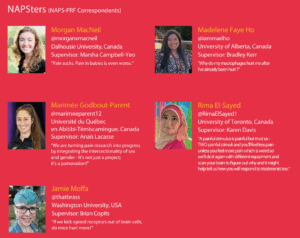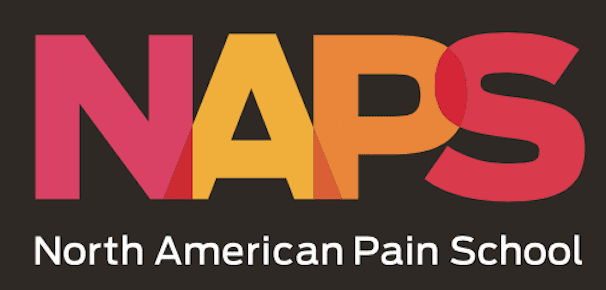Five early-career pain researchers are participating in the PRF-NAPS Correspondents program during the 2024 North American Pain School, taking place 23-28 June in Montebello, Québec City, Canada. The Correspondents program is a unique science communication training program that provides participants with knowledge and skills needed to communicate science effectively to a wide range of pain researchers, patients, and the greater public. The Correspondents will conduct interviews with NAPS Visiting Faculty and Patient Partners and provide live blogging, too! Take a look at their blog posts below.
NAPS Day 3 Blog Post
Scientific Disinformation: Prevention, Treatment, or Cure?
Today was like riding a roller coaster that never stops twisting and turning, but instead of feeling dizzy, I feel exhilarated every loop.

Image by Mammela on Pixabay
So many things happened today that it’s hard to believe it’s only been 24 hours. Maybe the magic of NAPS is bending time?
Today was packed with three workshops, each as fascinating as the next. Being passionate about scientific communication, I was captivated by Greg Carbonetti’s presentation: “How to Write about Your Research to People without (and with) Science Degrees.” For me, science only matters if it’s communicated effectively – reaching the right people at the right time.
Workshop #2. You’re probably thinking that a transition sentence would be ideal between workshops 1 and 2. I agree, but transitions here are nonexistent; it’s nonstop; we’re on a roller coaster, remember?
“Pain Testing in Humans.” Wow! Am I ready to immerse my hand in a bucket of ice water and rub capsaicin on my arm? In epidemiology, we don’t do this kind of thing. It’s like my brain forgot that to understand the phenomenon of pain, we need to test this pain in humans. Everyone survived, and it was one of the most interesting workshops of the week. Pain like this may be “funny” for an hour, but unbearable for a lifetime. The motivation to study chronic pain is at its peak. I’m in the right place.
Last workshop: “Academic Negotiation 101.” Honestly, I already know that if I find myself in this situation, I’ll be bad at it. The people pleaser, that’s me – and it’s not useful in that context.
Between all these incredible activities and a delicious BBQ dinner, I also had the chance to do a podcast with Melanie Noel. You absolutely must listen to it when it’s published! A 35-minute conversation, 100% authentic, between two people who forgot the context surrounding them.
Feeling dizzy after reading about this day? Welcome to NAPSLAND!
Marimée Godbout-Parent is a PhD candidate at the Université du Québec en Abitibi-Témiscamingue, Canada. You can follow her on Twitter/X – @marimeeparent12.
Today’s “self-actualization journey” update: 60% complete – even though it does not feel like it.
After my previous blog posts, you may have thought I was feeling the high of meeting everyone here and the pride of highlighting my project to a novel audience unfamiliar with my lab’s work. The last 48 hours, however, have been a journey into the “Valley of Despair,” as per the five phases of change (see Figure 1 below). This is a welcome despair, though, because it’s not actually despair, but rather how I’ve been humbled the past two days.

Figure 1. The five phases of change
My humbling highlights are as follows:
- Did you know that lactose is a common ingredient for prescription medications and over-the-counter drugs, despite lactose intolerance being a prevalent condition in the general population (including me)? Just imagine how many chronic pain patients exacerbate their pain (and other comorbidities) because of this narrowing limitation on what medications are accessible to them! I would not have learned that without hearing from the experienced voice of our Patient Partner Laurent Dupuis during Wednesday lunch. Thank you, Laurent.
- A number of my fellow NAPSters were recruited for workshops that challenged them in such creative ways: By reframing your talk through the “Style over Substance: Giving Better Talks” workshop held by Jeff Mogil, or by explaining your research in faster time intervals through the workshop held by Greg Carbonetti. I was awed by what my peers can do, and I felt such pride knowing the future of pain research was in bright, competent, assertive hands.
- Recording my interview with Calia Torres was a first-time “podcasting” experience for both of us. Despite feeling like we could have delved deeper into the conversation, I was truly humbled by the amazing work she has done in her career inspired by her passions. It inspired me to seek a future that fulfills my own passions and identity.
I treasure these moments of feeling humbled. They are a chance to challenge myself and feel inspired. As I write this, I already know I’m on the path up through “Informed Optimism.” At this pace, I’ll reach “Success and Fulfillment” soon!
Madelene Faye Ho is a PhD student at the University of Alberta, Canada. You can follow her on Twitter/X and Instagram – @iammadho.
It’s hard to believe there’s only one full day left at NAPS! It’s becoming increasingly difficult to condense the highlights from my day into a 300-word blog post.
The content at NAPS has opened my eyes to the important relationship between basic and clinical science – we can’t have one without the other. I never thought I would benefit from listening to scientists discuss results from studying rodents, but I’m intrigued. Ishmail Abdus-Saboor gave an overview of “Quantitative Approaches for Measuring Pain and Nociception,” and I could clearly see the connection between advances in basic science and how they translate to the clinical setting.
An interactive workshop led by our very own Greg Carbonetti reviewed the importance of tailoring your scientific communication to meet the learning needs and interests of your target audience. A big takeaway for me was learning how to get to the point! The “Half-Life” game (explaining your thesis in 60, 30, 15, and 5 seconds!) was a great way to practice this. For example, I’m studying whether babies’ brains, faces, and hearts say the same things during pain. That’s all you need to know!
I had my first encounter with capsaicin this afternoon during the “Studying Pain in Humans” workshop. I suppose it’s only fair that we get a taste of our own medicine and subject ourselves to commonly used methods of pain testing.
The biggest highlight of the day was having the opportunity to interview the one and only Michael Sullivan. If we didn’t have to keep a tight one-hour schedule, I would’ve talked with him all day. Stay tuned for our published interview – there’s a lot about him that you may not know!
As I write this blog while seated in the beautiful lobby of the Fairmont, surrounded by my fellow NAPSters, I feel immense gratitude.
Morgan MacNeil, RN, is a PhD candidate at Dalhousie University, Canada. You can follow her on Twitter/X – @morganxmacneil.
These last two days have been heartwarming and inspiring. Following my research presentation, I felt touched by all the wonderful friends I’ve made that cheered me on before and after. The support both NAPSters and the Visiting Faculty have given each other has been so authentic and lovely to experience. Each NAPSter has demonstrated their unique strengths, which have been encouraged and used as a tool for us to learn from each other.
As an example, during the workshop “Style over Substance: Giving Better Talks,” I felt inspired by the creative use of sketches, the captivating patient stories, and the excellent use of animations to walk the audience through the presentation. During another workshop on communicating science to a general audience, trainees were challenged to summarize their thesis in faster intervals (culminating in five seconds!). Despite the task becoming more challenging each round, it was remarkable how their statements became simpler and more direct, focusing on the impact of their work. The use of common props to describe pain-related topics was also really effective. It reminded me of one NAPSter who had a wonderful slide linking various combinations of proteins in a receptor to the various pieces of clothing in an outfit.
Beyond academic skills, Ted Price shared his experience starting multiple companies, and Ishmail Abdus-Saboor demonstrated robotics for more efficient and accessible research – which were eye-opening! It was great to learn that if you love academia but want to be an entrepreneur, there is a way to do that.
Getting to learn from each other’s experiences and strengths has been a privilege, and I know I’ll be applying this NAPS knowledge for years to come.
Rima El-Sayed is a PhD candidate at the University of Toronto, Canada. You can follow her on Twitter/X – @RimaElSayed1.
Scientific Disinformation: Prevention, Treatment, or Cure?
Is all science communication good? Is it always better to engage the public in science, even if the science is not quite right? What about dead wrong? Today’s workshop on communicating science to a general audience sparked tricky conversations about the dark underbelly of science outreach.
One of the most popular podcasts in the world is a “science communication” podcast. That’s great, right? It shows that people are interested in understanding the world around them. Except … it’s full of incorrect information and sales pitches disguised as scientific fact, dressed up in impressive credentials. In a climate of intense distrust for the scientific and medical communities, the fact that one of the most popular personalities is peddling disinformation is deeply concerning.
How should scientists respond to the mass dissemination of disinformation? We can start by not alienating our audience. The most popular science podcasts, YouTube channels, and TikTok creators succeed because they help the audience understand the topic without feeling stupid. In this morning’s workshop we learned how impenetrable jargon can be, but also that the goal should never be to “dumb down” the science. In combating disinformation, it will be essential to present sophisticated, jargon-free rebuttals while also avoiding direct personal attacks, which could further entrench incorrect beliefs.
Still, any attempts to debunk scientific disinformation follow behind the lies themselves, and often struggle to gain the same traction among the public. As the adage goes, “A lie can get halfway around the world before the truth gets its shoes on.” Can we prevent scientific misinformation? Can we direct our science communication and policy efforts towards inoculating people against misleading claims, rather than refuting them? I don’t have the answers, but I wonder if redirecting our efforts towards prevention would be the more efficient – and effective – path.
Jamie Moffa is a PhD candidate at Washington University, USA. You can follow them on Twitter/X – @thatbrass.
The 2024 PRF-NAPS Correspondents



